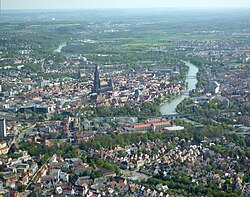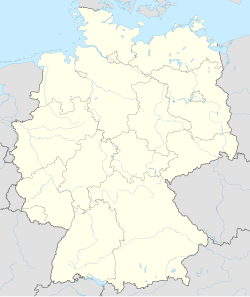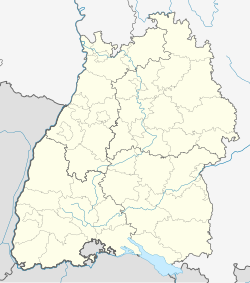Ulm
Ulm | |
|---|---|
 Ulm with the Ulm Minster | |
| Coordinates: 48°24′N 09°59′E / 48.400°N 9.983°E | |
| Country | Germany |
| State | Baden-Württemberg |
| Admin. region | Tübingen |
| District | Stadtkreis |
| Subdivisions | 18 Stadtteile |
| Government | |
| • Lord mayor | Gunter Czisch (CDU) |
| Area | |
| • Total | 118.69 km2 (45.83 sq mi) |
| Elevation | 478 m (1,568 ft) |
| Population (2021-12-31)[1] | |
| • Total | 126,949 |
| • Density | 1,100/km2 (2,800/sq mi) |
| Time zone | UTC+01:00 (CET) |
| • Summer (DST) | UTC+02:00 (CEST) |
| Postal codes | 89073–89081 |
| Dialling codes | 0731, 07304, 07305, 07346 |
| Vehicle registration | UL |
| Website | www |
Ulm is a city in Germany, in the state of Baden-Württemberg. It was started in about 850 AD.
Ulm is on the left side of the river Danube. Across the river on the right side is Neu-Ulm in Bavaria. Together they have more than 170,000 inhabitants. Ulm alone has about 120,000 inhabitants.
The university of Ulm was started in 1967. It has about 7,000 students.
The world's highest church tower is the Ulm Minster in Ulm. It is 161.5 metres (530 feet) tall. Also, Ulm has the oldest city theatre in Germany. Albert Einstein was born in Ulm.
References[change | change source]
- ↑ "Bevölkerung nach Nationalität und Geschlecht am 31. Dezember 2021" [Population by nationality and sex as of December 31, 2021] (CSV) (in German). Statistisches Landesamt Baden-Württemberg. June 2022.
Other websites[change | change source]
![]() Media related to Ulm at Wikimedia Commons
Media related to Ulm at Wikimedia Commons





